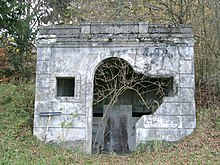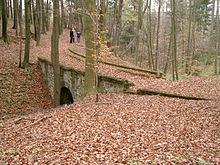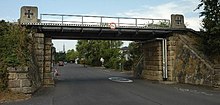Feldbach prisoner of war camp
The 1915 built POW camp Feldbach (Steiermark) later became one of the largest military hospitals of the Austro-Hungarian Empire , but also an important production facility for the military.

prehistory
The Imperial Lieutenancy Graz was awarded in September 1914 by the Austro-Hungarian military command Graz commissioned in the communities Feldbach , Fürstenfeld , Leibnitz and Knittelfeld a suitable place to set up a POW camp to locate.
On December 12, 1914, the Mayor of Feldbach was informed by the Villavicencio Lieutenancy Council that his parish had been selected. The final decision of a commission for an area east of Feldbach was made on December 14th.
Mayor König explained the situation to the local council on December 23. With regard to additional work and income opportunities for the community members, he saw the establishment of the camp as positive, for him the risk of the spread of infectious diseases was negative .
On the same day, the site manager, Captain Felix Schmidt, arrived with his staff in Feldbach to start the preparations.
Barracks were to be built for around 2,000 guards from the Imperial and Royal Landsturmwachbataillon No. 19 and 20 officers, 20,000 prisoners as well as hospital and isolation barracks, a total of around 100 buildings. The area required for this was leased for a period of six years for 200 crowns per yoke. At the end of the war in 1918, a total of 92 hectares were built.
POW camp
On December 28, the construction crew of 51 Russian prisoners of war and five guards arrived to begin construction. In the spring of 1915 there were already around 35,000 prisoners and guards in the camp, at the time of the peak in May / June 1915 there were 45–50,000 prisoners (inside and outside the camp in work groups), guards and administrative staff.
A local electricity company took care of the supply of electricity, the drinking water required came from the camp's own wells, which reached a depth of between 40 and 100 meters. A loading service was organized at Feldbach train station and a gendarmerie post was set up to guard it .
Bread was originally supplied by local bakeries. With increasing demand, however, four own bakeries, each with four ovens, and a flour and bread depot were built. A slaughterhouse with a cold store followed.
The fire risk was great because of the wooden construction of the barracks . That is why there was a separate campfire brigade with hydrants and electric fire alarms.
As can be seen on a propaganda film, barrel toilets that were emptied into the Raab served as sanitary facilities . (Whether this was a "permanent condition" or just an emergency solution during the initial phase is unknown.)
The hostile entry into the war by the actually allied Italy completely changed the situation. Nobody knew how the situation on the Isonzo front would develop and, for security reasons, the War Department did not want a POW camp to be so close to a front, as this would only increase the chances of a successful escape. The order followed to evacuate the Feldbach and Knittelfeld camps . The prisoners of war were to be transferred to the Ostfyasszonyta camp in Hungary . Only the prisoners assigned to the construction management were to remain (approx. 4,000 men).
The further fate of the Feldbach camp was unclear during the months of June and July. In any case, it was assigned to the 5th Army Command in Adelsberg .
hospital
At the end of July 1915, the order was given to convert the POW camp into a hospital with a capacity of 5,000 wounded within eight days . In addition, three kuk reserve hospitals were relocated to Feldbach.
In order to meet the tight deadline, all ongoing work on the camp had to be interrupted and the prisoners of war and local craftsmen had to be assigned to the necessary renovation work.
In the spring of 1916 the new hospital met the strict requirements of a review committee.
It had a centrally heated surgical group with two operating theaters , an eye clinic and an X-ray system . The washing and disinfection facilities intended for the POW camp were converted into hospital laundries and a steam laundry was also built. In addition, a morgue and a dissecting room were built.
A bacteriological institute was set up for fear of infectious diseases brought in by the wounded . State-of-the-art methods and the best microscopes were used in the experimental pavilion like only a few large hospitals.
Workshop
In addition to the hospital, there was also the workshop group. Originally this was only intended for repairs and to cover the warehouse's own needs. But in April 1915 the workshops were expanded. In order to develop the greatest possible productivity, approx. 7,800 prisoners of war worked in shifts .
Between September and mid-November, 300 barracks were built as winter quarters for the 10th Army . By the end of the war, 3000 barracks had been built, which were delivered to the entire monarchy, but also to Albania and Constantinople . But other products were also made (hand grenade handles, shoe nails, sled runners, shooting targets, snow shovels, fire buckets, ...)
Because the construction of the POW camp was neglected due to the time pressure during the construction of the POW camp, the paths had to be paved afterwards. For this purpose, work teams were assigned to work in the quarries in Mühldorf and Weißenbach near Feldbach. At the Steinberg in Mühldorf a separate external warehouse was also built.
To facilitate transport in and out of the camp in 1916/ 17 established a rail siding from which, after the war, the country's railway Feldbach-Bad Gleichenberg to Bad Gleichenberg emerged.
Test track of the field railway
During the First World War, a secret railway test route was laid out for the entire monarchy. The route and bridge structures are still preserved. The rails have been removed. An association in Feldbach tries to preserve and possibly restore it.
Nothing is known about the end of the prisoner-of-war camp or the hospital.
As already mentioned, what remains of the camp is the siding, which was later extended to the Feldbach – Bad Gleichenberg regional railway. On a website, a railway bridge in Feldbach, which is decorated with two iron crosses on its east side, is noted as a landmark of Feldbach. A little further north, on a disused part of the railway line, there is another bridge from this construction period, which is decorated with symbols of the Austrian / Hungarian monarchy.
The construction manager of the Feldbach prisoner of war camp, Captain Felix von Schmidt, also directed the filming of the Feldbach camp. Not only the construction of the camp, but also its conversion into the hospital, the hygienic precautionary measures and the operation of the workshops were documented . The film with a running time of 30 minutes has been preserved and has found its place in the Filmarchiv Austria .
reception
Two rooms in the museum in the Tabor in Feldbach are dedicated to the prisoner of war camp . There are also some exhibits, mainly wood carvings by Russian prisoners of war and camp inventory.
literature
- Wolfram Dornik - Rudolf Grasmug, Southeast Styria in the 20th Century, in: Wolfram Dornik - Rudolf Grasmug - Stefan Karner (ed.), GrenzenLos. Austria, Slovenia and Hungary 1914-2004. Contribution volume to the exhibition in the Gerberhaus Fehring, Graz - Fehring 2007, 117 f.
- Rudolf Grasmug, 125 years city of Feldbach. City book, Feldbach 2009, 358–385.
- Peter Hansak: The prisoner-of-war system during World War I in what is now Styria . phil. Diss. University of Graz 1991, 52–80, 187–189.
- Johann Schleich : POW camp Feldbach - Mühldorf 1914-1918 , 2013, ISBN 978-3-85333-236-8 .
Web links
Coordinates: 46 ° 56 ′ 23.8 " N , 15 ° 54 ′ 41.2" E





